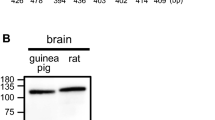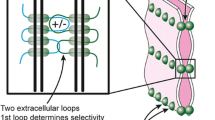Abstract
Objective
To detect the expression of Epac1 and Epac2 in the inner ear of guinea pigs and its association with microcirculation in the inner ear.
Methods
The temporal bones of 30 healthy red-eye guinea pigs (60 ears) weighing 200–350 g were collected, then the surrounding bone wall of the cochlea was removed under a dissection microscope. Real-time quantitative PCR (RT-qPCR) and Western blot were used to detect mRNA and protein expression, respectively, of Epac1 and Epac2 in the inner ear and to compare their expression in heart, liver, kidney, intestine, and lung tissues. The specimens of the cochlea included the stria vascularis, basilar membrane, saccule, and utricles isolated under a microscope to detect the localization of Epac1 and Epac2 proteins in various parts of the inner ear through immunofluorescence staining.
Results
The RT-qPCR and Western blot results showed that Epac1 mRNA was universally expressed in the inner ear, heart, liver, kidneys, intestines, and lungs, and was highly expressed in the liver, kidneys, and intestines (p < 0.05 vs heart, liver, kidney, intestine; p > 0.05 vs lung). Epac2 mRNA was expressed in the inner ear and heart, but not in the liver, kidneys, intestines, or lungs (p < 0.05 vs Heart). Epac1 and Epac2 proteins were both expressed in the inner ear, heart, liver, kidneys, intestines, and lungs. The relative expression of Epac1 proteins in the inner ear was significantly different from the liver, kidneys, intestines, and lungs (p < 0.05). The relative expression of Epac2 proteins in the inner ear was significantly different from the liver, kidneys, and lungs (p < 0.05), but not from the heart (p = 0.127) or intestines (p = 0.274). Immunofluorescence staining observed under confocal microscopy indicated that Epac1 and Epac2 proteins were expressed in the stria vascularis, basilar membrane, saccule, and utricles of the inner ear. They were expressed in maginal cells, intermediate cells, and basal cells of the stria vascularis, and highly expressed in capillary endothelial cells.
Conclusions
Epac1 and Epac2 mRNA and proteins were both expressed in the inner ear of guinea pigs and evenly expressed in the spiral ganglion, basilar membrane, saccule, and utricles. However, their expression in capillary endothelial cells of the stria vascularis was more obvious, suggesting that cyclic adenosine monophosphate–Epac1 signaling may play an important role in maintaining the function of the blood–labyrinth barrier and regulating the stability of microcirculation in the inner ear.



Similar content being viewed by others
References
Takumida M et al (2012) Localization of aquaporins 1, 2, and 3 and vasopressin type 2 receptor in the mouse inner ear. Acta Otolaryngol 132(8):807
Li X et al (2014) Observation of permeability of blood–labyrinth barrier during cytomegalovirus-induced hearing loss. Int J Pediatr Otorhinolaryngol 78(7):995–999
Yao X, Rarey KE (1996) Localization of the mineralocorticoid receptor in rat cochlear tissue. Acta Otolaryngol 116(3):493–496
(2010) Expression and translocation of aquaporin-2 in the endolymphatic sac in patients with Meniere's disease. J Neuroendocrinol 22(11):1157–1164
Banerjee U, Cheng X (2015) Exchange protein directly activated by cAMP encoded by the mammalian rapgef3 gene: structure, function and therapeutics. Gene 570(2):157–167
De-Rooij J et al (1998) Epac is a Rap1 guanine-nucleotide-exchange factor directly activated by cyclic AMP. Nature 396(6710):474
Bos JL (2003) Epac: a new cAMP target and new avenues in cAMP research. Nat Rev Mol Cell Biol 4(9):733–738
Pannekoek WJ et al (2011) Epac1 and PDZ-GEF cooperate in Rap1 mediated endothelial junction control. Cell Signal 23(12):2056–2064
Murtazina R et al (2007) Tissue-specific regulation of sodium/proton exchanger isoform 3 activity in Na(+)/H(+) exchanger regulatory factor 1 (NHERF1) null mice. cAMP inhibition is differentially dependent on NHERF1 and exchange protein directly activated by cAMP in ileum versus p. J Biol Chem 282(34):25141–25151
Yip KP (2006) Epac-mediated Ca2+ mobilization and exocytosis in inner medullary collecting duct. Am J Physiol 291(4):882–890
Laroche-Joubert N et al (2002) Protein kinase A-independent activation of ERK and H, K-ATPase by cAMP in native kidney cells—role of Epac I. J Biol Chem 277(21):18598–18604
Spindler V et al (2011) Ultrastructural analysis reveals cAMP-dependent enhancement of microvascular endothelial barrier functions via Rac1-mediated reorganization of intercellular junctions. Am J Pathol 178(5):2424–2436
(2020) Epac1 null mice have nephrogenic diabetes insipidus with deficient corticopapillary osmotic gradient and weaker collecting duct tight junctions. Acta Physiologica 229(1)
Yuan Y et al (2019) Epac agonist improves barrier function in iPSC-derived endothelial colony forming cells for whole organ tissue engineering. Biomaterials 200:25–34
Kawasaki H et al (1999) A family of cAMP-binding proteins that directly activate Rap1. Science 282(5397):2275–2279
Robichaux WG, Cheng X (2018) Intracellular cAMP sensor EPAC: physiology, pathophysiology, and therapeutics development. Physiol Rev 98(2):919–1053
Birukova AA et al (2007) Prostaglandins PGE(2) and PGI(2) promote endothelial barrier enhancement via PKA- and Epac1/Rap1-dependent Rac activation. Exp Cell Res 313(11):2504–2520
Kooistra MRH et al (2005) Epac1 regulates integrity of endothelial cell junctions through VE-cadherin. FEBS Lett 579(22):4966–4972
Rampers Ad SN et al (2010) Cyclic AMP phosphodiesterase 4D (PDE4D) tethers EPAC1 in a vascular endothelial cadherin (VE-Cad)-based signaling complex and controls cAMP-mediated vascular permeability. J Biol Chem 285(44):33614–33622
Sehrawat S et al (2008) Role of Epac1, an exchange factor for Rap GTPases, in endothelial microtubule dynamics and barrier function. Mol Biol Cell 19(3):1261–1270
Ramos et al (2018) The Epac-Rap1 pathway prevents and reverses cytokine-induced retinal vascular permeability. Biol Chem 293(2):717–730
Kopperud RK et al (2017) Increased microvascular permeability in mice lacking Epac1 (Rapgef3). Acta Physiol 219:441–452
Cuínas A et al (2016) Activation of PKA and Epac proteins by cyclic AMP depletes intracellular calcium stores and reduces calcium availability for vasoconstriction. Life Sci 155:102–109
Xla B et al (2020) Gadolinium-enhanced MRI reveals dynamic development of endolymphatic hydrops in Ménière’s disease. Braz J Otorhinolaryngol 86(2):165–173
Funding
(1) The Development Projects For Science and Technology of Chinese Medicine of Jiangsu Province (N202009). (2) Key R & D Plan (Social Development) Project of Xuzhou Science and Technology Bureau (KC20067). (3) Postgraduate Research & Practice Innovation Program of Jiangsu Province (SJCX20_0930). (4) National Natural Science Foundation of China, 81570917, 81600802, 81771009. The authors have no other funding, financial relationships, or conflicts of interest to disclose.
Author information
Authors and Affiliations
Corresponding author
Additional information
Publisher's Note
Springer Nature remains neutral with regard to jurisdictional claims in published maps and institutional affiliations.
Rights and permissions
About this article
Cite this article
Wang, C., Li, Y., Liu, W. et al. The expression and significance of Epac1 and Epac2 in the inner ear of guinea pigs. Eur Arch Otorhinolaryngol 279, 5207–5214 (2022). https://doi.org/10.1007/s00405-022-07380-0
Received:
Accepted:
Published:
Issue Date:
DOI: https://doi.org/10.1007/s00405-022-07380-0




